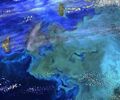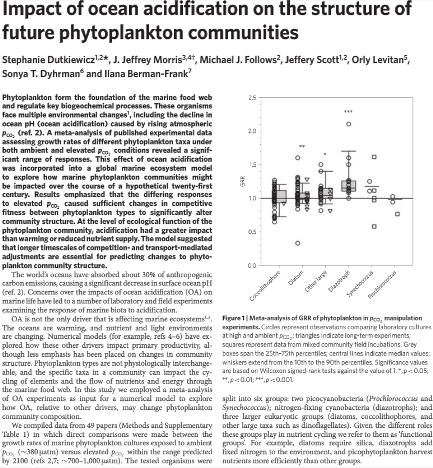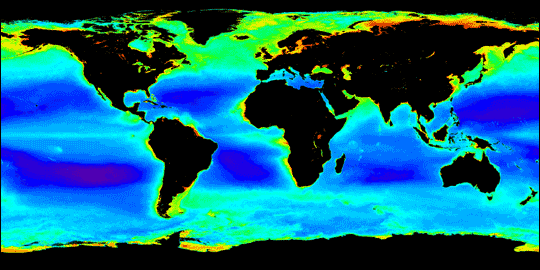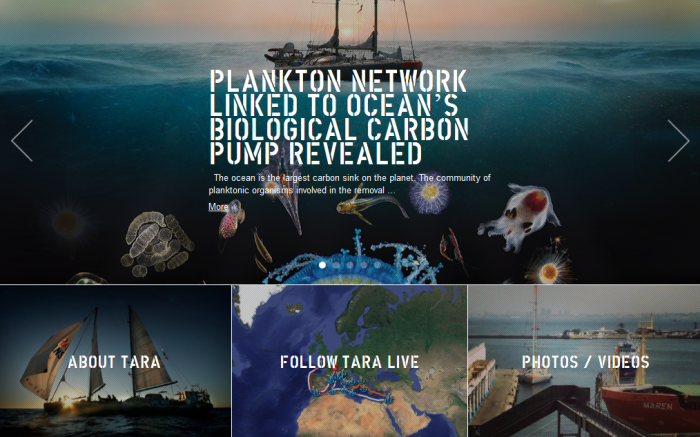File:Plankton Phytoplankton--'Climate Dance'.jpg: Difference between revisions
Siterunner (talk | contribs) No edit summary |
Siterunner (talk | contribs) No edit summary |
||
| Line 16: | Line 16: | ||
<big><big>'''NASA Ocean Satellite Data Shows ‘Climate Dance’ of Plankton'''</big></big> | <big><big>'''NASA Ocean Satellite Data Shows ‘Climate Dance’ of Plankton'''</big></big> | ||
:''' | :'''A new critically vital database ... 'Plankton' / ''' -- http://www.bbc.com/news/science-environment-32831814 | ||
'''The Marine Food Chain''' | <big>'''The Marine Food Chain... and Much More'''</big> | ||
The greens and blues of the ocean color from NASA satellite data have provided new insights into how climate and ecosystem processes affect the growth cycles of phytoplankton—microscopic aquatic plants important for fish populations and Earth’s carbon cycle. | The greens and blues of the ocean color from NASA satellite data have provided new insights into how climate and ecosystem processes affect the growth cycles of phytoplankton—microscopic aquatic plants important for fish populations and Earth’s carbon cycle. | ||
Revision as of 22:22, 13 October 2017
Life in the Oceans, Life on Earth
- "A single kind of blue-green algae in the ocean produces the oxygen in one of every five breaths we take"
- ~ from "The World Is Blue: How Our Fate and the Ocean’s Are One" by Sylvia Earle
Visit GreenPolicy360's newest site -- www.tinybluegreen.com
○ ○ ○ ○ ○ ○ ○ ○ ○ ○ ○ ○ ○ ○ ○ ○ ○ ○ ○ ○ ○ ○ ○ ○ ○ ○ ○ ○
NASA Ocean Satellite Data Shows ‘Climate Dance’ of Plankton
- A new critically vital database ... 'Plankton' / -- http://www.bbc.com/news/science-environment-32831814
The Marine Food Chain... and Much More
The greens and blues of the ocean color from NASA satellite data have provided new insights into how climate and ecosystem processes affect the growth cycles of phytoplankton—microscopic aquatic plants important for fish populations and Earth’s carbon cycle.
At the bottom of the ocean’s food chain, phytoplankton account for roughly half of the net photosynthesis on Earth. Their photosynthesis consumes carbon dioxide and plays a key role in transferring carbon from the atmosphere to the ocean. Unlike the plant ecosystems on land, the amount of phytoplankton in the ocean is always followed closely by the abundance of organisms that eat phytoplankton, creating a perpetual dance between predators and prey.
This new analysis shows how tiny imbalances in this predator-prey relationship, caused by environmental variability, give rise to massive phytoplankton blooms, having huge impacts on ocean productivity, fisheries and carbon cycling. The study was released Thursday, Sept. 25, in the journal Nature Climate Change.
“The continuous year-in and year-out measurements provided by NASA’s ocean color satellites have dramatically changed our understanding of phytoplankton dynamics on the Earth,” said Mike Behrenfeld, author of the study and phytoplankton ecologist at Oregon State University, Corvallis, Oregon. “What we now see is a closely linked system of phytoplankton cell division and consumption lying at the heart of the plant’s annual cycle.”
Behrenfeld calls this close predator-prey relationship the “Dance of the Plankton.” This view is different from previous perspectives that have simply focused on environmental resources used by phytoplankton to grow, such as nutrients and light. The new view is important because it reveals that tiny imbalances can greatly impact Earth’s ecology.
Credit: NASA's Goddard Space Flight Center, Norman Kuring; USGS
+NASA Goddard
+USGS News:Mapping, Remote Sensing, Geospatial Data #NASA #Satellite #Earth #Ocean #Phytoplankton #Biology #Life #Climate #Ecosystem #Science #CarbonCycle #Aquatic #Photosynthesis
_ _ _ _ _ _
SMALL v LARGE SPECIES
Phytoplankton obtain energy through the process of photosynthesis and must therefore live in the well-lit surface layer (termed the euphotic zone) of an ocean, sea, lake, or other body of water. Phytoplankton account for half of all photosynthetic activity on Earth.
Phytoplankton are responsible for much of the oxygen present in the Earth’s atmosphere – half of the total amount produced by all plant life. http://en.wikipedia.org/wiki/Phytoplankton
○
Marine Biodiversity Strongly Linked to Ocean Temperature
ScienceDaily / 2010 — In an unprecedented effort published online by the international journal Nature, a team of scientists mapped and analyzed global biodiversity patterns for over 11,000 marine species ranging from tiny plankton to sharks and whales.
The researchers found striking similarities among the distribution patterns, with temperature strongly linked to biodiversity for all thirteen groups studied. These results imply that future changes in ocean temperature, such as those due to climate change, may greatly affect the distribution of life in the sea.
http://www.sciencedaily.com/releases/2010/07/100728131707.htm
○
Plankton
2015 - Big Trouble Ahead for Ocean Plankton
Sobering news: Ocean acidification will likely kill off some phytoplankton species and let others thrive, while warming waters will likely cause mass phytoplankton migrations toward the poles. In short: The base of the marine food web could be in for some serious upheaval in the coming decades. Here’s more from MIT News:
“I’ve always been a total believer in climate change, and I try not to be an alarmist, because it’s not good for anyone,” says (Dr. Stephanie) Dutkiewicz, who is the paper’s lead author. “But I was actually quite shocked by the results. The fact that there are so many different possible changes, that different phytoplankton respond differently, means there might be some quite traumatic changes in the communities over the course of the 21st century. A whole rearrangement of the communities means something to both the food web further up, but also for things like cycling of carbon.”
Dutkiewicz and her colleagues studied 154 published experiments...
~ ~ ~ ~ ~ ~ ~
○ ○ ○ ○ ○ ○ ○ ○ ○ ○ ○ ○ ○ ○ ○ ○ ○ ○ ○ ○
Science is just beginning to study the role of 'the tiny little ones' in the oceans
Removing Carbon, Adding Oxygen: Plankton's Role is Critically Important
http://www.nature.com/nature/journal/vaop/ncurrent/full/nature16942.html
The biological carbon pump is the process by which CO2 is transformed to organic carbon via photosynthesis, exported through sinking particles, and finally sequestered in the deep ocean. While the intensity of the pump correlates with plankton community composition, the underlying ecosystem structure driving the process remains largely uncharacterized. Here we use environmental and metagenomic data gathered during the Tara Oceans expedition to improve our understanding of carbon export in the oligotrophic ocean....
○ ○ ○ ○ ○ ○ ○ ○ ○ ○ ○ ○ ○
Feb 10, 2016 -- Via Phys.org
Plankton carries carbon to safe resting spot, ocean study reveals
The ocean's power to rein in carbon and protect the environment is vast but not well-understood.
But now, an international team of scientists has begun to illuminate how the ocean plucks carbon from the atmosphere, where it contributes to global warming, and shuttles it to the bottom of the sea.
The new study establishes the important role of plankton networks in removing carbon from the atmosphere and depositing it deep in the ocean. And it opens up opportunities for caring for the ocean in ways that encourage it to absorb more carbon.
The knowledge comes out of the unprecedented three-year Tara Oceans Expedition, in which a team of more than 200 experts took to the sea to catalog and better understand the unseen inhabitants of the ocean, from tiny animals to viruses and bacteria.
---
Be a Planktonaut!
The Tara Project
http://oceans.taraexpeditions.org/en/m/about-tara/
http://oceans.taraexpeditions.org/en/
○ ○ ○ ○ ○ ○ ○ ○ ○ ○ ○ ○ ○
http://planktonchronicles.org/en/the-project/
○ ○ ○ ○ ○ ○ ○ ○ ○ ○ ○ ○ ○
Plankton's effect on ocean's carbon storage
http://phys.org/news/2015-05-uncovering-diversity-invisible-ocean-world.html
http://phys.org/news/2015-11-rapid-plankton-growth-ocean-carbon.html#nRlv
http://phys.org/news/2013-02-climate-clues-tiny-marine-algaeancient.html#nRlv
File history
Click on a date/time to view the file as it appeared at that time.
| Date/Time | Thumbnail | Dimensions | User | Comment | |
|---|---|---|---|---|---|
| current | 20:18, 4 May 2015 |  | 773 × 644 (161 KB) | Siterunner (talk | contribs) | Category:Green Graphics |
You cannot overwrite this file.
File usage
The following 16 pages use this file:
- Book Reviews @GreenPolicy
- Citizen Science
- Earth Science Research from Space
- Earthviews from Astronauts
- Ecolivia
- GreenPolicy360 Archive Highlights 2015
- TinyBlueGreen
- File:Earths two lungs.png
- File:Phytoplankton.jpg
- File:Sylvia Earle quote.png
- File:The World Is Blue.jpg
- Category:Earth Observations
- Category:Microbiology
- Category:Ocean Ecosystem
- Category:Oceans
- Category:Planet Citizens, Planet Scientists
- Biodiversity
- Citizen Science
- Earth360
- Earth Observations
- Earth Science
- Ecology Studies
- Ecoregions
- Environmental Full-cost Accounting
- Environmental Security
- Environmental Security, National Security
- EOS eco Operating System
- Externalities
- Fisheries
- Green Graphics
- ISS
- Land Ethic
- Oceans
- Ocean Ecosystem
- Ocean Science
- Planet Citizen
- Planet Scientist
- Planet Citizens, Planet Scientists
- Sustainability
- Sustainability Policies
- Biogeosciences
- Climate Change
- Geophysics and Geochemistry
- Hydrology
- Natural Resources
- Ocean Sustainability


